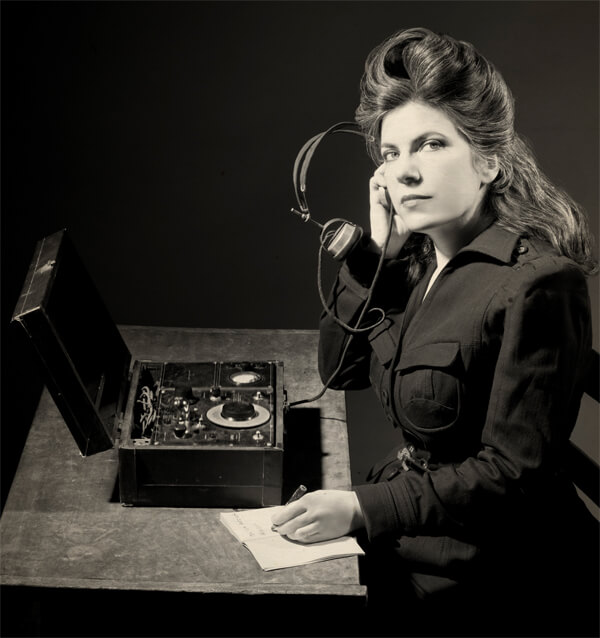Update Monday, September 10: the Gaudeamus Prize 2012 was won by Christian Heuer (1989, Germany).The prize of € 4550 comes in the form of a commission for a new piece, to be performed in the Gaudeamus Music Week next year. There were two honorable mentions, for Maxim Shalygin (1985, Ukraine/Netherlands) and Edward Hamel (1986, USA).
Annie Gosfield is a composer/performer who is inspired as much by noise and other unusual sounds as by traditional instruments. On her latest album ‘Almost Truths and Open Deceptions’, she brings together these varied interests. In her own words: “I’ve always led parallel musical lives, balancing playing in my own band with composing notated music for others. This cd reflects the full spectrum of these intertwined existences, from a noisy five minute blast by my band to a chamber cello concerto that follows a 100-page score.” Gosfield is one of the jury members for the Gaudeamus Competition for composers under thirty. I spoke to her after the opening concert on September 3, 2012, in the Geertekerk in Utrecht, and she answered five questions…
Did you ever take part in the Gaudeamus Competition yourself?
I didn’t. Actually I never took part in any competition, but I applied for many grants, which is a sort of contest too. In some ways, I might be philosophically opposed to the word competition: you can’t choose a ‘winner’ out of an enormous bulk of pieces, for everyone is going to hear them differently. Yet I agreed to become a member of the jury because I love the program, that offers a wide variety of contemporary compositions. Another positive aspect is that all the thirteen works we selected will be performed, so it’s even beneficial for composers who don’t win the prize. It’s great Gaudeamus gives young composers a chance to hear their pieces performed in the context of works written by older and more renowned colleagues.

Annie Gosfield
How many works were submitted?
Almost three hundred. Each of the three jurors – Martijn Padding, Christopher Butterfield and myself – listened to all of them. People not only submitted scores, but audio files as well. Usually you get to do ‘homework’, but Gaudeamus just put us in a room together for three solid days, with the scores and music on computers. This process worked out surprisingly well, for each of us started with a different group of pieces, divided by number. So if you were really burnt-out, and on your 280th score, somebody would have gotten this in their first pile, and still have a fresh look. Also, when you heard something really interesting, you could stop your computer and say: hey, come and listen to this, what do you think?
Was it difficult to reach a common verdict?
Well, we all have a slightly different esthetic, but we agree on a lot as well. So we were confident that if there was something we missed, one or two of the others would draw our attention to that particular piece. This happened a few times. Some things I chose were of no interest to my fellow jurors, but others were really raised from the ashes. As in many of these situations, I think we totally agreed on about 75% of the entries, and then we agreed pretty much up to 90%. After this you start pulling out the knives – over the last two or three pieces the jurors themselves tend to become a bit competitive. But all in all we’re very happy with the thirteen pieces we selected, and there was enough room to include some we didn’t all agree on.
How many works you immediately related to?
Hard to say. To speak in terms of baseball: you have to figure out your strike-zone – what is the acceptable level of a piece? This takes a few to listen to, but I’d say there were probably six I felt very strongly about, and then another ten I wished to do well. One striking difference between me and my two colleagues was that I tended to really like noise, and things influenced by noise, whereas they tended to first look at the score, analyzing how a piece was orchestrated. So for me it was basically about the sound, while they rather looked at how the composers had gotten there. This is interesting, for it goes against what one might consider likely in terms of gender. Also, I was maybe less sympathetic towards certain things I found well done, but cliché, such as scores with a strong Helmut Lachenmann influence, or employing a lot of extended techniques. But these are young composers that haven’t quite developed yet, so they may hand in something really brilliant next time.
How come only one woman made it to the jury selection?
I really don’t know, for we got to judge the pieces anonymously. Which I think was a great part of the process: we had no idea what age, what gender, what country people were from. It was very surprising to me that only one woman ended up in our jury selection, and I have no explanation for this. It could be a reflection of the gender balance of the submissions, yet I can’t tell. I like to think there is no difference between what sounds like a woman’s writing and what sounds like a man’s. My own music is a good example of this. You wouldn’t call it typically feminine and lyrical, or male and aggressive. I’m convinced each composer creates their own mix of what they do.
Stats: 278 pieces were submitted by composers from 37 different countries, 58 entries coming from the United States. The winner will be announced on Sunday, September 9.
—
Thea Derks is a Dutch music journalist, specializing in contemporary music. She’s writing a biography on Reinbert de Leeuw, due for publication in 2013. Follow her on twitter: @tdrks





















